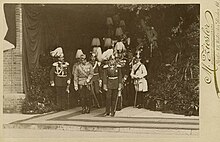1889 waltz by Johann Baptist Strauss II
Emperors Wilhelm II and Franz Joseph I during the latter’s visit to Berlin in 1889 Kaiser-Walzer Emperor Waltz waltz composed by Johann Strauss II in 1889. The waltz was originally titled Hand in Hand and was intended as a toast made in August of that year by Emperor of Austria Franz Joseph I on the occasion of his visit to the German Emperor Wilhelm II where it was symbolic as a 'toast of friendship' extended by Austria-Hungary to the German Empire .
Strauss' publisher, Fritz Simrock , suggested the title Kaiser-Walzer, since the title could allude to either monarch. The waltz was first performed in Berlin on 21 October 1889. The original cover of the piano edition bore the illustration of the Austrian Imperial Crown.
Composition
A quiet march starts the waltz's introduction before a sweeping crescendo heralds the gentle principal melody of the first waltz. As more waltz sections are introduced, the mood remains constantly upbeat and triumphant. A cello solo, rather like a cadenza , near the end of the work reprises the melody of the first waltz section, before a trumpet fanfare ushers the end of the work, complete with a drumroll on the timpani and a strong brass flourish.
Waltz 2
Instrumentation
It is scored for 2 flutes, 2 oboes, 2 clarinets, 2 bassoons, 4 horns, 2 trumpets, 3 trombones, timpani, cymbals, bass drum, snare drum, harp, and strings.
References
Based on original text by Peter Kemp, The Johann Strauss Society of Great Britain. Used with permission.
External links
Operettas Waltzes
Sinngedichte , Op. 1 (1844)Gunstwerber , Op. 4 (1844)Sträußchen , Op. 15 (1846)Klange aus der Walachei , Op. 50 (1850)Frohsinns-Spenden , Op. 73 (1850)Lava-Ströme , Op. 74 (1850)Rhadamantus-Klänge , Op. 94 (1851)Idyllen , Op. 95 (1851)Mephistos Höllenrufe , Op. 101 (1851)Liebeslieder , Op. 114 (1852)Phönix-Schwingen , Op. 125 (1853)Novellen , Op. 146 (1854)Nachtfalter , Op. 157 (1855)Glossen , Op. 163 (1855)Man lebt nur einmal! , Op. 167 (1855)Abschieds-Rufe , Op. 179 (1856)Phänomene , Op. 193 (1857)Abschied von St. Petersburg , Op. 210 (1858)Hell und voll , Op. 216 (1859)Promotionen , Op. 221 (1859)Accelerationen , Op. 234 (1860)Immer heiterer , Op. 235 (1860)Grillenbanner , Op. 247 (1861)Klangfiguren , Op. 251, (1861)Dividenden , Op. 252Karnevalsbotschafter , Op. 270 (1862)Leitartikel , Op. 273 (1863)Morgenblätter , Op. 279 (1863)Studentenlust , Op. 285 (1864)Aus den Bergen , Op. 292 (1864)Bürgersinn , Op. 295 (1865)Flugschriften , Op. 300 (1865)Wiener Bonbons , Op. 307 (1866)An der schönen blauen Donau , Op. 314 (1867)Künstlerleben , Op. 316 (1867)Die Publicisten , Op. 321 (1868)G'schichten aus dem Wienerwald , Op. 325 (1868)Illustrationen , Op. 331 (1869)Wein, Weib und Gesang , Op. 333 (1869)Freuet euch des Lebens , Op. 340 (1870)Neu Wien , Op. 342 (1870)Tausend und eine Nacht , Op. 346 (1871)Wiener Blut (waltz) , Op. 354 (1873)Carnevalsbilder , Op. 357 (1873)Bei uns z'Haus , Op. 361 (1873)Wo die Zitronen blühen , Op. 364 (1874)Du und du , Op. 367 (1874)Cagliostro-Walzer , Op. 370 (1875)O schöner Mai! , Op. 375 (1877)Rosen aus dem Süden , Op. 388 (1880)Nordseebilder , Op. 390 (1880)Kuss-Walzer , Op. 400 (1881)Frühlingsstimmen , Op. 410 (1883)Lagunen-Walzer , Op. 411 (1883)Schatz-Walzer , Op. 418 (1885)Wiener Frauen , Op. 423 (1886)Donauweibchen , Op. 427 (1887)Kaiser-Jubiläum-Jubelwalzer , Op. 434 (1888)Kaiser-Walzer , Op. 437 (1888)Rathausball-Tänze , Op. 438 (1890)Gross-Wien , Op. 440 (1891)Seid umschlungen, Millionen! , Op. 443 (1892)Gartenlaube Waltz , Op. 461 (1894)Trau, schau, wem! , Op. 463 (1895)Farewell to America Polkas
Herzenslust , Op. 3Explosions-Polka , Op. 43Champagner-Polka , Op. 211 (1858)Tritsch-Tratsch-Polka , Op. 214 (1858)Demolirer , Op. 269 (1862)Vergnügungszug , Op. 281 (1864)'S gibt nur a Kaiserstadt, 's gibt nur a Wien! , Op. 291Lob der Frauen , Op. 315Postillon d'amour , Op. 317 (1867)Leichtes Blut , Op. 319 (1867)Figaro-Polka , Op. 320 (1867)Ein Herz, ein Sinn! , Op. 323Freikugeln , Op. 326 (1868)Éljen a Magyar! , Op. 332Im Krapfenwald'l , Op. 336 (1869)Die Bajadere , Op. 351Vom Donaustrande , Op. 356Bitte schön! , Op. 372 (1875)Auf der Jagd , Op. 373 (1875)Banditen-Galopp , Op. 378 (1877)Waldine , Op. 385 (1879)Neue Pizzicato Polka , Op. 449 Marches Quadrilles Other Family In media
International National Other




